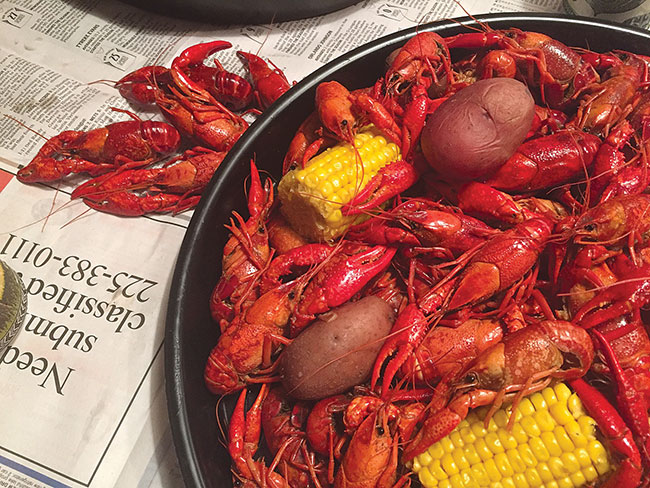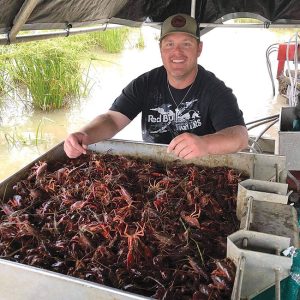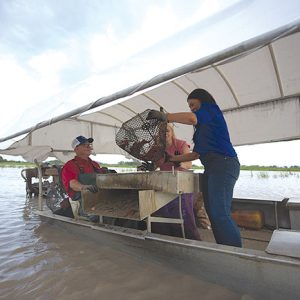
Crawfish popularity hits new high
January 3, 2022
By Julia Hollister
 Boiled crawfish is a delicious staple in the southern states Photo: Louisiana Seafood Promotion and Marketing Board
Boiled crawfish is a delicious staple in the southern states Photo: Louisiana Seafood Promotion and Marketing Board They are called by many names: crawfish, crayfish, crawdads and mudbugs; but by any name, their popularity is booming.
According to Samantha Carroll, executive director of the Louisiana Seafood Promotion and Marketing Board in Baton Rouge, the popularity of US crawfish is growing not just in the US but also in China.
“We saw firsthand just how big of a deal crawfish is in China now during a Louisiana Tourism promotional trip our office took years ago to Beijing,” said Carroll. “They had streets lined with hundreds and hundreds of restaurants, with four-hour waits for people to eat crawfish. Of course we waited and it was quite funny because the waitress assured us we wouldn’t know how to eat them.
“Little did she know we were from Louisiana and that we’re experts in all things crawfish. My husband and his family have their own crawfish farm in Louisiana.”
Commercial farming of crawfish began in the late 1800s. Prior to that, people were fishing for wild crawfish in bayous and other natural waters in Louisiana.
“Crawfish popularity has grown dramatically within the last 15 years and continues to grow at astounding rates,” said Justin Smith of the Louisiana Crawfish Co in Natchitoches, LA. “When people taste them they have to have them again and again.”
Fame came to crawfish in 1983 when it was designated as Louisiana’s official crustacean.
In 2019, Louisiana recorded over 250,000 acres of crawfish ponds and over 1,600 farmers. The state harvests around 150 million lbs of crawfish annually, which contributes a whopping $300 million to the state economy.
Carroll says imports have taken some of the market from US-farmed crawfish.
“You could purchase a $10 pack of crawfish tails from China, but the product probably wasn’t tested properly (because of their lax regulations),” she said. “It could contain illegal antibiotics or additives that have been known to cause stomach cancer. Or you can pay $3-$5 more and support US domestic seafood that is free of any of those mystery additives.”
Crawfish farming
More than 50 percent of Louisiana’s crawfish aquaculture is practiced in conjunction with rice production because crawfish farming fits well into many existing farm operations, said the Louisiana State University AgCenter.
Besides, rice fields are ideal for growing crawfish because these creatures like the same clay soil that makes rice crops thrive, according to Acadia Crawfish of Louisiana.
The ponds-cum-rice fields harvest two crops. After the rice is harvested, the farmers switch gears to plant crawfish seeds.
Seeds for crayfish are mostly wild-caught. According to Acadia Crawfish, the seeds often come from the Atchafalaya Basin, the largest area of river swamp in the US.
“The 140-mile-long stretch of water is home to hundreds of species, including crawfish. Current estimates are that the basin produces 22 million pounds of crawfish during the commercial harvests,” the farmer said on its website.
The crawfish seed are planted in June. In ideal conditions, they can be harvested in 3-4 months. They can grow to 50 g (1.8 oz) and 2-5 inches long. Typically, medium to large is the best size to harvest.
They are harvested from amphibious boats. Traps are baited with fish and when crawfish go into the trap they are unable to get back out.
“Mud bugs is probably my favorite name,” said Garett Marcantel, owner of Double Bayou Crawfish Company in Anahuac, Texas. “The scientific name is Procambarus clarkii, the ‘red swamp’ crawfish.”
“I am a first-generation farmer and this is my fourth year in production,” he said. “It’s been one hell of an expensive, time-consuming, learning curve but it is a passion I intend to see through in hopes for generational wealth and stability.”
There are 7,000 acres of crawfish farmed in southeastern portion of Texas. Marcantel farms 200 acres. For the farmer, the crawfish season really never ends but from “flood up” (when the fields are pumped with up to 12 inches of water for crawfish to grow) to drain is October to July. Harvesting typically slowly begins in January then picks up from March to May.
Climate seems to be the reason crawfish are limited to certain areas in the Southeastern US. The milder winters to warmer summers suit them well. Louisiana and Texas are known for the red swamp and white river crawfish. There are over 300 different species found throughout the world and some species of crawfish are found in most rivers and inland ponds throughout the US. Most agree that crawfish live 3-5 years; but 8-10 years is possible.
Louisiana farmers are up against weather and dealing with the constant rise and fall of market pricing.
According to Marcantel, there are not enough words to describe fully the challenges of crawfish farming, but these include fluctuations in weather: too cold or too hot weather affects them differently; water quality, crawfish densities in a field; equipment failures; insufficient forage crop such as rice, sorghum, sudan grass or natural aquatic vegetation; and invasive aquatic vegetation like water hyacinth and invasive fish.
“On the bright side, the opportunities are endless,” he said. “You get to meet people from all walks of life so the door is always open for new unexpected things to come.
“The best thing is the joy in bringing my friends and family together each weekend to feast on ‘mud bugs’. My tricks to make them, unlike anywhere else, is to include chili peppers –Habaneros, and Serronos – fresh peeled garlic, Tabasco sauce, olive oil, lemons and two secret ingredients that I can’t share.”







